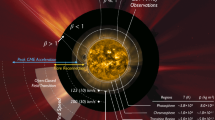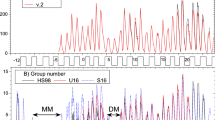Abstract
We study the relationship between polar field reversals and decayed active region magnetic flux. Photospheric active region flux is dispersed by differential rotation and turbulent diffusion, and is transported poleward by meridional flows and diffusion. We summarize the published evidence from observation and modeling of the influence of meridional flow variations and decaying active region flux’s spatial distribution, such as the Joy’s law tilt angle. Using NSO Kitt Peak synoptic magnetograms covering cycles 21–24, we investigate in detail the relationship between the transport of decayed active region flux to high latitudes and changes in the polar field strength, including reversals in the magnetic polarity at the poles. By means of stack plots of low- and high-latitude slices of the synoptic magnetograms, the dispersal of flux from low to high latitudes is tracked, and the timing of this dispersal is compared to the polar field changes. In the most abrupt cases of polar field reversal, a few activity complexes (systems of active regions) are identified as the main cause. The poleward transport of large quantities of decayed trailing-polarity flux from these complexes is found to correlate well in time with the abrupt polar field changes. In each case, significant latitudinal displacements were found between the positive and negative flux centroids of the complexes, consistent with Joy’s law bipole tilt with trailing-polarity flux located poleward of leading-polarity flux. The activity complexes of the cycle 21 and 22 maxima were larger and longer-lived than those of the cycle 23 and 24 maxima, and the poleward surges were stronger and more unipolar and the polar field changes larger and faster. The cycle 21 and 22 polar reversals were dominated by only a few long-lived complexes whereas the cycle 23 and 24 reversals were the cumulative effects of more numerous, shorter-lived regions. We conclude that sizes and lifetimes of activity complexes are key to understanding the diversity of polar reversals.




















Similar content being viewed by others
References
H.W. Babcock, The topology of the sun’s magnetic field and the 22-year cycle. Astrophys. J. 133, 572 (1961). doi:10.1086/147060
S. Basu, H.M. Antia, Characteristics of solar meridional flows during Solar cycle 23. Astrophys. J. 717, 488–495 (2010). arXiv:1005.3031. doi:10.1088/0004-637X/717/1/488
R.H. Cameron, M. Schüssler, Changes of the solar meridional velocity profile during cycle 23 explained by flows toward the activity belts. Astrophys. J. 720, 1030–1032 (2010). arXiv:1007.2548. doi:10.1088/0004-637X/720/2/1030
R.H. Cameron, M. Schüssler, Are the strengths of solar cycles determined by converging flows towards the activity belts? Astron. Astrophys. 548, A57 (2012). arXiv:1210.7644. doi:10.1051/0004-6361/201219914
R. Cameron, M. Schüssler, The crucial role of surface magnetic fields for the solar dynamo. Science 347, 1333–1335 (2015). 1503.08469. doi:10.1126/science.1261470
R.H. Cameron, J. Jiang, D. Schmitt, M. Schüssler, Surface flux transport modeling for Solar cycles 15–21: Effects of cycle-dependent tilt angles of sunspot groups. Astrophys. J. 719, 264–270 (2010). arXiv:1006.3061. doi:10.1088/0004-637X/719/1/264
R.H. Cameron, M. Dasi-Espuig, J. Jiang, E. Işık, D. Schmitt, M. Schüssler, Limits to solar cycle predictability: Cross-equatorial flux plumes. Astron. Astrophys. 557, A141 (2013). arXiv:1308.2827. doi:10.1051/0004-6361/201321981
P. Charbonneau, Dynamo models of the solar cycle. Living Rev. Sol. Phys. 7, 3 (2010). doi:10.12942/lrsp-2010-3
M. Dasi-Espuig, S.K. Solanki, N.A. Krivova, R. Cameron, T. Peñuela, Sunspot group tilt angles and the strength of the solar cycle. Astron. Astrophys. 518, A7 (2010). arXiv:1005.1774. doi:10.1051/0004-6361/201014301
M. Dasi-Espuig, S.K. Solanki, N.A. Krivova, R. Cameron, T. Peñuela, Sunspot group tilt angles and the strength of the solar cycle (Corrigendum). Astron. Astrophys. 556, C3 (2013). doi:10.1051/0004-6361/201014301e
M. Dikpati, Polar field puzzle: Solutions from flux-transport dynamo and surface-transport models. Astrophys. J. 733, 90 (2011). arXiv:1104.0269. doi:10.1088/0004-637X/733/2/90
M. Dikpati, P.A. Gilman, Global solar dynamo models: Simulations and predictions of cyclic photospheric fields and long-term non-reversing interior fields. New J. Phys. 9, 297 (2007). doi:10.1088/1367-2630/9/8/297
C.J. Durrant, J.P.R. Turner, P.R. Wilson, The mechanism involved in the reversals of the sun’s polar magnetic fields. Sol. Phys. 222, 345–362 (2004). doi:10.1023/B:SOLA.0000043577.33961.82
T.L. Duvall Jr, Large-scale solar velocity fields. Sol. Phys. 63, 3–15 (1979). doi:10.1007/BF00155690
V. Gaizauskas, K.L. Harvey, J.W. Harvey, C. Zwaan, Large-scale patterns formed by solar active regions during the ascending phase of cycle 21. Astrophys. J. 265, 1056–1065 (1983). doi:10.1086/160747
V. Gaizauskas, D.H. Mackay, K.L. Harvey, Evolution of solar filament channels observed during a major poleward surge of photospheric magnetic flux. Astrophys. J. 558, 888–902 (2001). doi:10.1086/322298
G.E. Hale, S.B. Nicholson, The law of sun-spot polarity. Astrophys. J. 62, 270 (1925). doi:10.1086/142933
G.E. Hale, F. Ellerman, S.B. Nicholson, A.H. Joy, The magnetic polarity of sun-spots. Astrophys. J. 49, 153 (1919). doi:10.1086/142452
D.H. Hathaway, L. Rightmire, Variations in the Sun’s meridional flow over a solar cycle. Science 327, 1350 (2010). doi:10.1126/science.1181990
D.H. Hathaway, P.A. Gilman, J.W. Harvey, F. Hill, R.F. Howard, H.P. Jones, J.C. Kasher, J.W. Leibacher, J.A. Pintar, G.W. Simon, GONG observations of solar surface flows. Science 272, 1306–1309 (1996). doi:10.1126/science.272.5266.1306
J.T. Hoeksema, Structure and evolution of the large scale solar and heliospheric magnetic fields. PhD thesis, Stanford University, CA (1984)
V.G. Ivanov, Joy’s law and its features according to the data of three sunspot catalogs. Geomagn. Aeron. 52, 999–1004 (2012). doi:10.1134/S0016793212080130
J. Jiang, E. Işik, R.H. Cameron, D. Schmitt, M. Schüssler, The effect of activity-related meridional flow modulation on the strength of the solar polar magnetic field. Astrophys. J. 717, 597–602 (2010). arXiv:1005.5317. doi:10.1088/0004-637X/717/1/597
R.W. Komm, R.F. Howard, J.W. Harvey, Meridional flow of small photospheric magnetic features. Sol. Phys. 147, 207–223 (1993). doi:10.1007/BF00690713
B.J. Labonte, R. Howard, Solar rotation measurements at Mount Wilson. III—Meridional flow and limbshift. Sol. Phys. 80, 361–372 (1982). doi:10.1007/BF00147982
R.B. Leighton, Transport of magnetic fields on the Sun. Astrophys. J. 140, 1547 (1964). doi:10.1086/148058
R.B. Leighton, A magneto-kinematic model of the solar cycle. Astrophys. J. 156, 1 (1969). doi:10.1086/149943
A. Muñoz-Jaramillo, M. Dasi-Espuig, L.A. Balmaceda, E.E. DeLuca, Solar cycle propagation, memory, and prediction: Insights from a century of magnetic proxies. Astrophys. J. Lett. 767, L25 (2013). arXiv:1304.3151. doi:10.1088/2041-8205/767/2/L25
E.N. Parker, The formation of sunspots from the solar toroidal field. Astrophys. J. 121, 491 (1955). doi:10.1086/146010
G.J.D. Petrie, Evolution of active and polar photospheric magnetic fields during the rise of cycle 24 compared to previous cycles. Sol. Phys. 281, 577–598 (2012). arXiv:1204.1048. doi:10.1007/s11207-012-0117-3
G.J.D. Petrie, Solar magnetic activity cycles, coronal potential field models and eruption rates. Astrophys. J. 768, 162 (2013). arXiv:1303.1218. doi:10.1088/0004-637X/768/2/162
G.J.D. Petrie, Solar magnetism in the polar regions. Living Rev. Sol. Phys. (2015)
G.J.D. Petrie, I. Patrikeeva, A comparative study of magnetic fields in the solar photosphere and chromosphere at equatorial and polar latitudes. Astrophys. J. 699, 871–884 (2009). arXiv:1010.6041. doi:10.1088/0004-637X/699/1/871
G.J.D. Petrie, K. Petrovay, K. Schatten, Solar polar fields and the 22-year activity cycle: Observations and models. Space Sci. Rev. 186, 325–357 (2014). doi:10.1007/s11214-014-0064-4
K.H. Schatten, W.D. Pesnell, An early solar dynamo prediction: Cycle 23 is approximately cycle 22. Geophys. Res. Lett. 20, 2275–2278 (1993). doi:10.1029/93GL02431
K.H. Schatten, S. Sofia, Forecast of an exceptionally large even-numbered solar cycle. Geophys. Res. Lett. 14, 632–635 (1987). doi:10.1029/GL014i006p00632
K.H. Schatten, P.H. Scherrer, L. Svalgaard, J.M. Wilcox, Using dynamo theory to predict the sunspot number during solar cycle 21. Geophys. Res. Lett. 5, 411–414 (1978). doi:10.1029/GL005i005p00411
K. Schatten, D.J. Myers, S. Sofia, Solar activity forecast for solar cycle 23. Geophys. Res. Lett. 23, 605–608 (1996). doi:10.1029/96GL00451
C.J. Schrijver, Y. Liu, The global solar magnetic field through a full sunspot cycle: Observations and model results. Sol. Phys. 252, 19–31 (2008). doi:10.1007/s11207-008-9240-6
C.J. Schrijver, M.L. De Rosa, A.M. Title, What is missing from our understanding of long-term solar and heliospheric activity? Astrophys. J. 577, 1006–1012 (2002). doi:10.1086/342247
N.R. Sheeley Jr., C.R. DeVore, J.P. Boris, Simulations of the mean solar magnetic field during sunspot cycle 21. Sol. Phys. 98, 219–239 (1985). doi:10.1007/BF00152457
H.B. Snodgrass, Magnetic rotation of the solar photosphere. Astrophys. J. 270, 288–299 (1983). doi:10.1086/161121
X. Sun, J.T. Hoeksema, Y. Liu, J. Zhao, On polar magnetic field reversal and surface flux transport during solar cycle 24. Astrophys. J. 798, 114 (2015). 1410.8867. doi:10.1088/0004-637X/798/2/114
L. Svalgaard, T.L. Duvall Jr., P.H. Scherrer, The strength of the sun’s polar fields. Sol. Phys. 58, 225–239 (1978). doi:10.1007/BF00157268
R.K. Ulrich, The controversial sun, in IAU Colloq. 137: Inside the Stars, ed. by W.W. Weiss, A. Baglin. Astronomical Society of the Pacific Conference Series, vol. 40 (Astronomical Society of the Pacific, San Francisco, 1993), pp. 25–42
Y.M. Wang, N.R. Sheeley Jr., Magnetic flux transport and the sun’s dipole moment—new twists to the Babcock-Leighton model. Astrophys. J. 375, 761–770 (1991). doi:10.1086/170240
Y.M. Wang, N.R. Sheeley Jr., On potential field models of the solar corona. Astrophys. J. 392, 310–319 (1992). doi:10.1086/171430
Y.M. Wang, A.G. Nash, N.R. Sheeley Jr., Evolution of the sun’s polar fields during sunspot cycle 21—poleward surges and long-term behavior. Astrophys. J. 347, 529–539 (1989). doi:10.1086/168143
Y.M. Wang, J. Lean, N.R. Sheeley Jr., Role of a variable meridional flow in the secular evolution of the sun’s polar fields and open flux. Astrophys. J. Lett. 577, L53–L57 (2002). doi:10.1086/344196
Y.M. Wang, E. Robbrecht, N.R. Sheeley Jr., On the weakening of the polar magnetic fields during solar cycle 23. Astrophys. J. 707, 1372 (2009). doi:10.1088/0004-637X/707/2/1372
Acknowledgements
This work utilizes data obtained by the NSO Integrated Synoptic Program (NISP), managed by the National Solar Observatory, which is operated by the Association of Universities for Research in Astronomy (AURA), Inc. under a cooperative agreement with the National Science Foundation. SE’s contribution to this work was carried out through the National Solar Observatory Summer Research Assistantship (SRA) Program.
Author information
Authors and Affiliations
Corresponding author
Rights and permissions
About this article
Cite this article
Petrie, G., Ettinger, S. Polar Field Reversals and Active Region Decay. Space Sci Rev 210, 77–108 (2017). https://doi.org/10.1007/s11214-015-0189-0
Received:
Accepted:
Published:
Issue Date:
DOI: https://doi.org/10.1007/s11214-015-0189-0




